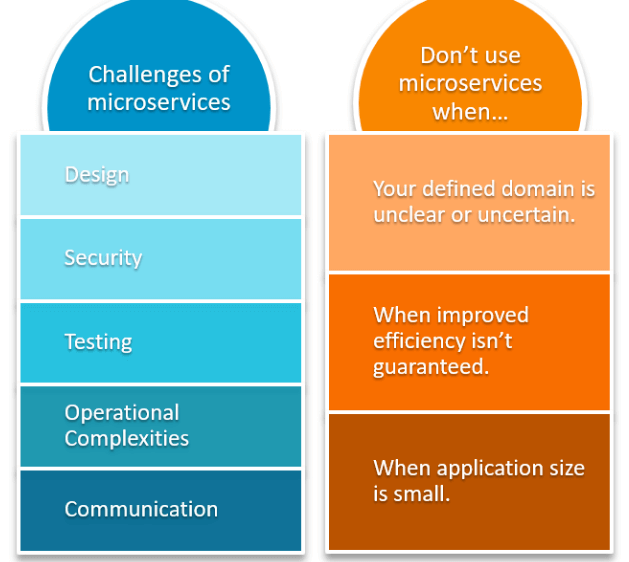Challenges of Microservices Architecture
In this tutorial, we are going to discuss the challenges of microservices architecture. Microservices have significant benefits but also have significant challenges. Moving from monolith to microservices means a lot more management complexity. Here are some of the challenges we need to consider before applying to microservices architecture.

Complexity
Microservices application has lots of services that need to work together and should create value. Since there are lots of services, that means there are more moving parts than the monolithic application. Each service is simpler, but the entire system is more complex. Even deployments can be complicated for hundreds of services deploy different times hard to manage versions. Think about the communication. It’s really easy to communicate components in monolithic applications because it is inter-process communication, can be the same machine and same process.
But microservices communication is a hard topic and need to have a strategy to manage inter-service communications between server even different geo-locations.
Network problems and latency
So since microservices are small and communicate with inter-service communication, we should manage network problems. If we call a chain of services for a particular request, this will increase latency problems and need the correct design to APIs for proper communication. In order to avoid chatty API calls. You need to consider asynchronous communication patterns like message broker systems.
Development and Testing
Think about the E2E process as one of the long business requirements. If the requirement touches on several microservices that need to act as 1 application, its hard to develop and test these E2E processes in microservices architectures if we compare them to monolithic ones. Existing tools are not always designed to work with service dependencies. Refactoring across service boundaries can be difficult.
Migrating the monolithic database to microservices.
Best practices claim that once you decide to break the monolith into microservices, the monolithic database must be broken into parts, too. Otherwise, if multiple services remain tied to the same tables in the database, there is a risk that any change made in one service will result in cascading changes in other microservices. Then, the whole point of using microservices can be defeated.
Data Integrity
Microservice has its own data persistence. So data consistency can be a challenge. Mostly we should follow eventual consistency where possible. But transactional operations are always will be challenging.
Nevertheless, these challenges aren’t stopping adopting microservices. Most of the organizations accept these challenges and adapt their technologies to microservices architecture in order to get the benefits of this architecture.
Security
Microservices are often deployed across multi-cloud environments, resulting in increased risk and loss of control and visibility of application components—resulting in additional vulnerable points. Compounding the challenge, each microservice communicates with others via various infrastructure layers, making it even harder to test for these vulnerabilities.
Technology diversity and increased resource use.
Each and every microservice team is free to decide what technologies to use for development and deployment. This results in great technological diversity within one project and makes microservices more difficult from a technical perspective than monoliths. So, for things to run smoothly and without breakdowns, companies need to be sure they can at all times provide the necessary talent for ongoing operations and maintenance of each implemented service. Besides, that can result in higher infrastructure costs.
The risk of network security being compromised
Inter-service communication presents new security challenges that may be difficult to address using traditional means. A microservice-based app consists of multiple moving parts and thus is prone to security vulnerabilities. With microservices that normally utilize various APIs, there is an increased chance of the network being taken over with malicious intent. All in all, security and resilience must always be a concern when operating infrastructure of tens or even hundreds of microservices.